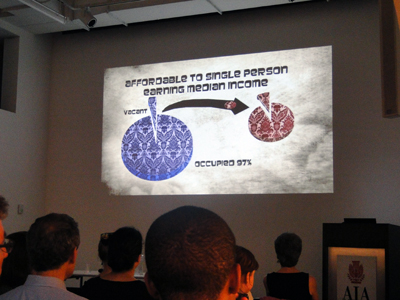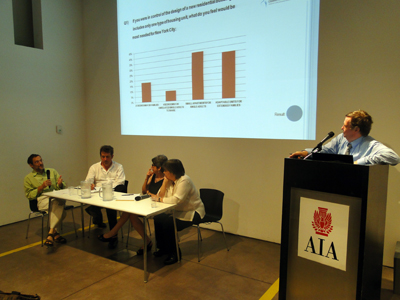by: Daniel Fox

As a still from the film suggests, it is becoming difficult for single people earning a median income to find housing.
Daniel Fox

The panelists discuss the results of an audience survey. The slide on the screen indicates that if only one type of housing unit were to be built, the majority wished it to be small apartments for single adults.
Daniel Fox
Event: Making Room: Film Screening and Panel Discussion
Location: Center for Architecture, 08.09.12
Moderator: Ernie Hutton, FAICP, Assoc. AIA
Speakers: Jerilyn Perine, Executive Director, Citizens Housing & Planning Council (CHPC); Mark Ginsberg, FAIA, Chair, CHPC; John Shapiro, AICP, Chair, Pratt Institute Planning & Sustainability; Marcie Kesner, AICP, Kramer Levin Naftalis & Frankel LLP
Organizers: AIANY Planning and Urban Design Committee and the Citizens Housing &
Planning Council
According to the Citizens Housing and Planning Council (CHPC), data models show that there is “a substantial mismatch between the types of housing units available in New York City and the shape of our 21st-century households. Our diverse households – predominantly single people – are trying to fit themselves into homes and apartments not designed for their needs. And our housing is unable to evolve because the size, shape, and even occupancy requirements of our homes are governed by old-fashioned laws and codes.” This research illustrates scientifically what we all know anecdotally and personally: if you’re single in New York and, like “Home Alone’s” Kevin McCallister, just want to live alone, you’re pretty much out of luck when it comes to finding an affordable studio.
What about the almost one million people expected to move to New York by 2030? The more popular New York becomes – especially for the young and single – the fewer one’s (legal) housing options become, as new stock is not keeping up with the aforementioned changes in our households. And those dated codes? According to Curtis + Ginsberg Architects Principal and CHPC Chair Mark Ginsberg, FAIA, “four different pieces of regulation define family in three different ways.”
So, what should we do? According to the CHPC and its Executive Director Jerilyn Perine, innovative design is part of the solution: new architectural forms, micro units like those proposed by Mayor Bloomberg’s adAPT NYC initiative, and studios with multi-purpose furniture, for example, are good starts. And although New York has the eighth largest per-capita population of single people, Perine affirmed that it should be at the forefront of thinking about creative solutions for single people.
At “Making Room: Film Screening and Panel Discussion,” we screened a film that documented the CHPC’s “Making Room” design showcase, held last November with the Architectural League of New York. Proposals from the five teams suggested a range of ways in which we can meet our pressing needs through new design and policy.
One of the most provocative schemes was by Stan Allen, FAIA, and Rafi Segal, who suggested that we take 1950s and ’60s office buildings and insert residential units, with two office floors becoming three residential ones; the core of these residential units would remain office and shared space. Azby Brown, director of the KIT Future Design Institute in Tokyo, suggested that we “edit life” like the Japanese, reducing stuff while increasing its usefulness.
All of the teams’ excellent presentations can be seen on CHPC’s website. Feasibility aside, wonderful things can come from imaginative design, and this is only the first step in the CHPC’s plan to “transform the housing options for all New Yorkers for the years to come.”
Daniel Fox is AIANY Communications Manager and Editor-in-Chief of e-Oculus.









